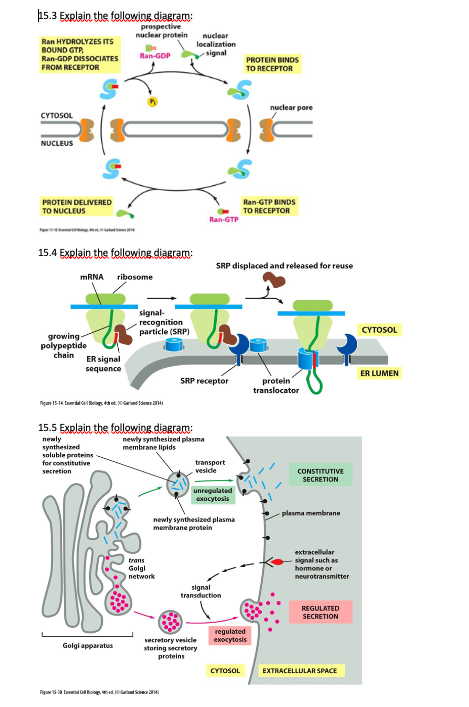

SRP binds N-terminal signal sequence of the nascent polypeptide chain of secretory protein (chain of colored circles), pauses the translation and targets ribosome-nascent chain complex to SRP receptor (dark grey) in ER membrane. Scenario 1–During normal biogenesis, secretory proteins are recognized by SRP (orange crescent) during their synthesis on ribosome (violet ovals). (B) SRP cycle and possible dysregulation. The SRP protein subunits are assembled on 7SL RNA (orange, from PDB 1RY1 ( Halic et al., 2004)), and composed of Alu domain proteins SRP9 (magenta, from PDB 1RY1 ( Halic et al., 2004)) and SRP14 (teal, from PDB 1RY1 ( Halic et al., 2004)) and S-domain proteins: SRP72 (purple, from PDB 5WRW ( Gao et al., 2017)), SRP68 (light blue, from PDB 5WRV and 4P3F ( Grotwinkel et al., 2014 Gao et al., 2017)), SRP19 (green, from PDB 1RY1 ( Halic et al., 2004)), and SRP54 (dark blue, from PDB 1MFQ and 1RY1 ( Kuglstatter et al., 2002 Halic et al., 2004)).
#RELEASES NEW PEPTIDES INTO ER LUMEN SRP SOFTWARE#
The picture was prepared using PyMol software ( Schroedinger 2020). Signal Recognition Particle (SRP) and human diseases. Thus, defects in SRP biogenesis and mutations in SRP subunits may have pathological effects on a large number of these substrates leading to human diseases.įIGURE 1. It is estimated that more than 30% of eukaryotic proteins are secretory or membrane proteins ( Uhlen et al., 2015), and many of them may be targeted by SRP. The SRP cycle is reviewed in detail in ( Kellogg et al., 2021). SRP leaves the complex, translation elongation resumes, and the nascent polypeptide chain is translocated through the translocon into the ER lumen. Finally, SRP hands over the ribosome to the SEC61 translocon and hydrolyzes GTP. SRP-ribosome complexes then move to the SRP receptor on the ER membrane. First, SRP recognizes signal sequences of secretory proteins upon their exposure from the ribosome during translation, leading to elongation arrest.
#RELEASES NEW PEPTIDES INTO ER LUMEN SRP SERIES#
SRP targets proteins using a series of events called the SRP cycle ( Figure 1B Scenario 1). SRP is divided into two major domains: the Alu (7SL RNA Alu region with SRP9 and SRP14 proteins) which functions in elongation arrest and the S or signal recognition domain (7SL RNA S region with SRP19, SRP54, SRP68, and SRP72 proteins). SRP is a ribonucleoprotein consisting of six protein subunits arranged on a long noncoding RNA called 7SL RNA ( Figure 1A). Many secretory and membrane proteins undergo co-translational targeting to the endoplasmic reticulum (ER) governed by the signal recognition particle (SRP). In this work, we analyze diseases caused by SRP failure and discuss their possible molecular mechanisms. Indeed, SRP dysfunction is involved in many different human diseases, including: congenital neutropenia idiopathic inflammatory myopathy viral, protozoal, and prion infections and cancer. All these events lead to dramatic consequence for protein biogenesis, activating protein quality control pathways, and creating pressure on cell physiology, and might lead to the pathogenesis of disease. If SRP recognizes the substrates but is unable to target them to ER, they may mislocalize or degrade. If SRP is depleted or cannot recognize the signal sequence, then the Regulation of Aberrant Protein Production (RAPP) is activated, which results in the loss of secretory protein mRNA. It co-translationally targets proteins with a signal sequence to the endoplasmic reticulum (ER) and protects their mRNA from degradation. The signal recognition particle (SRP) is a ribonucleoprotein complex with dual functions. Department of Cell Biology and Biochemistry, Texas Tech University Health Sciences Center, Lubbock, TX, United States.


 0 kommentar(er)
0 kommentar(er)
